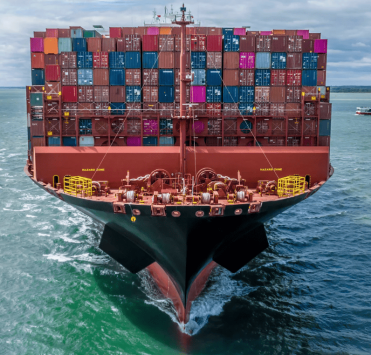Major international ports of China: the maritime gateway to world trade

China is not only the factory of the world, but also the most important hub of the global logistics infrastructure. Its seaports handle a huge volume of exports and imports, ensuring the stability of supply chains around the world. China's major international ports play a key role in container transportation, transshipment of bulk and liquid cargo, and the development of logistics corridors under the One Belt, One Road initiative.
In this article, we will take a closer look at the largest ports in China, their infrastructure features, cargo turnover and importance in the global maritime logistics. We will also consider how to choose the right port for export and import operations.
1. Shanghai Port - the largest seaport in the world
The Port of Shanghai is one of the largest ports in China and around the world. In terms of container traffic, it consistently ranks first, handling more than 47 million TEUs (twenty-foot equivalent units) per year.
Features of the port of Shanghai:
- Located on the east coast of China at the mouth of the Yangtze River.
- It consists of several terminals: Yangshan Deep-Water Port, Waigaoqiao Port, etc.
- It is well connected to the country's rail and road network.
- It is used for both containerized and general cargo, oil, chemicals, and automobiles.
The Port of Shanghai is the main hub for exports from China to the United States, Europe, Southeast Asia and other regions. Thanks to its deep water and modern infrastructure, the port is able to handle the largest ocean-going vessels.

2. Ningbo-Zhoushan Port is a strategic logistics center
Ningbo-Zhoushan Port, located in Zhejiang Province, is one of the fastest growing international ports in China. In recent years, it has overtaken even the port of Shanghai in terms of cargo turnover, taking into account not only containers but also bulk and liquid cargo.
Features of the port of Ningbo:
- One of the deepest ports in the world.
- Ideal for transshipment of oil, coal, iron ore and other raw materials.
- Modern container terminals and active participation in the Green Port program.
More than 35 million TEU of containers and 1.2 billion tons of total cargo turnover make this port one of the key ones in the global maritime trade. It serves domestic and international destinations, including Europe, the Middle East, America and Africa.
3. Shenzhen Port is a high-tech maritime hub in the South of China
Shenzhen Port, located in one of the most dynamic cities in China, is the most important logistics center near Hong Kong. It includes several major terminals such as Yantian, Shekou, Chiwan and Mawan.
Features:
- One of the largest ports in South China in terms of container turnover.
- Specializes in handling high-tech goods and electronics.
- It is closely connected with the industrial zones of Shenzhen and the southern province of Guangdong.
Container turnover exceeds 27 million TEU per year, making Shenzhen the third most important port in China after Shanghai and Ningbo. Thanks to its developed logistics infrastructure and close integration with production zones, the port is used to ship goods from China to all over the world.
4. Guangzhou Port - the oldest port with a modern face
Guangzhou Port has more than two thousand years of history. Today, it is one of the most versatile ports, handling both containerized and bulk cargo.
Features:
- One of the largest ports in South China.
- Container turnover is over 23 million TEU.
- It actively serves the supply of minerals, agricultural products, and chemicals.
The port is also an important center of domestic logistics, connecting the Chinese hinterland with the coast. It participates in the international program for the development of the Maritime Silk Roads.
5. Qingdao Port - a center of trade in the northeast
Qingdao Port is a port located in Shandong Province, specializing in the transshipment of iron ore, oil, chemicals and containerized cargo. It serves large industrial and raw material flows and is an important hub for trade with Japan, Korea and Southeast Asian countries.
Features:
- Modern terminals: the automated container terminal is considered one of the most advanced in the world.
- Container turnover: over 23 million TEU.
- Integration with China's railway network and ports in Inner Mongolia.

6. Tianjin Port - the gateway to Northern China
The Tianjin Port is the largest port in northern China and the main sea gateway to the capital Beijing. It serves both international and domestic routes, serving as the logistics center for the entire Bohai Bay region.
Features:
- A deep-water port capable of handling supertankers and mega-container ships.
- Container handling: about 22 million TEU.
- Tight integration with rail and road infrastructure.
The port is actively developing as part of the Digital Port strategy, which makes it attractive to exporters and importers focused on smart logistics solutions.
7. Hong Kong Port is a historic center of international trade
Hong Kong Port has long been a symbol of China's openness and global integration into world trade. Despite the fact that competition with continental ports has increased significantly, Hong Kong continues to be an important logistics and financial center for international transportation.
The main characteristics of the port of Hong Kong:
- Depth and infrastructure: Thanks to its naturally deep water, the port has developed a well-developed infrastructure that ensures high throughput of maritime transportation.
- Historical significance: Over decades of operation, the port has become a platform for numerous innovative solutions in the field of logistics and container transportation.
- Specialization: In addition to standard container operations, the port serves projects for the export of premium products, high-tech equipment, and transships specialized cargo, including chemicals and industrial equipment.
- Logistics integration: Good transport accessibility via road and rail networks makes the port even more attractive to importers and exporters.
Thanks to its flexibility and adaptability, the Port of Hong Kong remains important in an increasingly competitive environment, remaining a major transportation point for shipments to ASEAN, Europe, the United States and the Middle East.
8. Dalian Port - the northern window of China
Dalian Port is located on the southern coast of the Liaodong Peninsula and is an important logistics center in the northeast of the country. It is one of the key hubs for transshipment of various types of cargo, including both containerized and general cargo.
Key aspects of Dalian Port:
- Geographical location: Due to its location on the border with Japan and Korea, Dalian Port is an optimal route for deliveries to the North Asian regions.
- Transport accessibility: Strong connections to inland routes via the railroad network and highways ensure efficient distribution of cargo across the region.
- Modern infrastructure: The port is equipped with modern crane complexes and automated handling systems, which allows it to handle a huge number of containers annually.
- Cargo specialization: The main emphasis is on the transshipment of mineral resources, industrial goods, as well as the transportation of high-tech products.
Dalian Port ensures close integration of regional trade with global markets and serves as an important link in the supply chain for the economies of neighboring countries.
9. Xiamen Port - the southern pearl of modern logistics
Xiamen Port is located in Fujian Province and is a dynamically and constantly developing logistics hub in southeastern China. It is aimed at servicing both domestic and international transportation.
Features of the port of Xiamen:
- Innovative technologies: The port is actively implementing modern information systems to manage cargo flows, which significantly increases the efficiency of loading and unloading operations.
- Geographical advantages: Proximity to Taiwan and Southeast Asian countries makes it possible to organize prompt transportation of goods, minimizing time costs.
- Wide range of services: In addition to standard container transportation, the port of Xiamen handles bulk cargo, chemicals, agricultural products and machinery.
- Environmental focus: In recent years, the port has paid special attention to the development of green logistics, which includes reducing emissions and optimizing terminal operations in terms of energy consumption.
Xiamen Port's efficiency and technological capabilities contribute to the intensification of international trade with Southeast Asia and other regions, making it a competitive hub in the global logistics system.

10. Beihai Port - the gateway to southwestern China
The Beihai Port is located in the Guangxi Zhuang Autonomous Region and is one of the most important cargo transportation centers in southwestern China. It is actively developing in the context of the One Belt, One Road initiative, opening up new transportation corridors to the Southeast Asian region.
Characteristic features of the port of Beihai:
- Strategic location: Proximity to modern economic zones and transit routes makes Beihai Port attractive to exporters and importers.
- Cargo destinations: Mineral raw materials, agricultural products, and industrial equipment are actively transshipped in the port.
- Infrastructure development: Thanks to investments in expanding port capacities and modernizing equipment, the port is becoming increasingly popular in international trade.
- Efficiency of logistics processes: The use of modern information technology and automation systems ensures high speed of cargo handling and minimization of downtime.
Thus, the port of Beihai acts as an important link in the transportation network of the southwestern region of China, contributing to economic growth and the development of regional trade relations.
11. Haikou Port - the center of island logistics
Haikou Port, located on Hainan Island, is a unique transportation hub in a tropical climate. This port plays a significant role in ensuring the uninterrupted supply of goods for the domestic market and for export to Asian countries.
Key features:
- Tropical climate and infrastructure: Haikou combines modern cargo handling technology with the traditional logistics routes of the island region.
- Specialization: The port handles both containerized cargo and special category cargo, such as perishables, seafood, and travel goods.
- Connection to the mainland: Thanks to the development of rail and road routes, Haikou is effectively connected to the main economic centers of China.
The development of Haikou port reflects the adaptation of traditional transportation routes to modern logistics requirements, strengthening China's position in the global market, especially in the field of international tourism and export of tropical goods.
12. Zhanjiang Port - an important transit hub in the south
The Zhanjiang Port is located in the southern part of Guangdong Province and is one of the most promising centers for the transportation of oil products, chemicals, and heavy machinery. Due to its strategic location, Zhanjiang is becoming a significant logistics bridge between mainland China and South Asian markets.
Key characteristics of the port of Zhanjiang:
- Capacity expansion: The port is in the process of continuous expansion and modernization, which allows it to accommodate vessels with increased tonnage.
- Container turnover: In addition to standard container operations, the port of Zhanjiang is implementing projects to transship liquid and bulk cargo.
- Transport accessibility: The developed transportation network, including roads and railways, ensures the prompt distribution of goods throughout the country and abroad.
- Innovative technologies: The use of modern automated systems helps to reduce time costs and increase terminal throughput.
The port of Zhanjiang is becoming increasingly popular among companies interested in reducing logistics costs and optimizing delivery routes, as evidenced by the growth in cargo turnover and infrastructure investment.
Additional promising ports and infrastructure development
In addition to the above-mentioned major ports, China is actively developing and modernizing a number of additional maritime hubs that play an important role in the formation of a flexible and multi-level logistics network. Some of them are discussed below:
1. Yangtang Port.
- Location and development: Yangtang Port is located in close proximity to major industrial zones and is an important part of the regional logistics infrastructure. It serves both intra-Chinese and international transportation.
- Areas of application: Transshipment of chemical and petrochemical products, as well as the supply of components for the machine building industry.
- Technologies and innovations: The introduction of automated systems and digital platforms increases the efficiency of cargo handling, making the port competitive in the global market.
2. Fuzhou Port
- Infrastructure: The Port of Fujian is actively modernizing, including the construction of new terminals and the expansion of existing sites.
- Logistics capabilities: Thanks to its favorable geographical location, the port is a link between mainland China and the regions of Southeast Asia.
- Economic significance: Fujian serves as a starting point for the export of consumer goods, electronics and textile products.
3. Shijiazhuang Port
- Development features: Although less well known globally, the Shijiazhuang Port is strategically developing to improve transportation links between the country's key industrial centers.
- Specialization: The main focus is on general cargo transshipment and logistics support for regional production sites.
- Growth prospects: Investments in infrastructure and digitalization of processes provide the potential to increase traffic volumes in the coming years.
The role of China's ports in global trade
China's seaports play a fundamental role in shaping global supply chains. Their importance is determined not only by the volume of container handling, but also by their ability to provide a high level of service for various categories of cargo.
Global cargo turnover and strategic importance
- Exports and imports: China is one of the largest exporters and importers in the world. The main international ports of China, such as Shanghai Port, Ningbo-Zhoushan Port and Shenzhen Port, ensure timely delivery of goods to any corner of the world.
- Container transportation: The steady growth in container traffic confirms that China's maritime logistics meets international standards, meeting the needs of both small and medium-sized enterprises and large international corporations.
- Bulk and liquid cargo: The variety of types of cargo transported - from raw materials to finished goods - demonstrates the multifunctionality of ports and their ability to adapt to changing market demands.
Innovation and digitalization
- Modern technologies: The introduction of automation systems, artificial intelligence, and the Internet of Things makes it possible to manage cargo flows with maximum accuracy and efficiency. This is becoming an important competitive advantage for Chinese ports in the face of global competition.
- Smart ports: The smart port concept is implemented through the integration of information systems, which allows tracking every stage of cargo handling, from unloading to shipping, minimizing the risk of delays and errors.
- Environmental sustainability: Infrastructure modernization is accompanied by environmental initiatives aimed at reducing emissions and optimizing energy consumption. This is becoming an important factor for companies seeking to meet global environmental standards.
Competitive advantages for business
- Flexibility and adaptability: Chinese ports offer a wide range of services and are able to respond quickly to changes in global trade. This allows companies to choose the most profitable routes and reduce logistics costs.
- Integrated logistics: Modern ports are closely integrated with land transportation systems, including rail, road and air, providing a comprehensive approach to solving customers' problems.
- International cooperation: Chinese ports are actively developing partnerships with foreign port operators, which makes them key participants in the global transport and logistics network.
Keywords: advantages of Chinese ports, international logistics, exports from China, imports to China, competitive advantages of maritime logistics.
Choosing a port for business: what to consider?
When choosing a port in China to organize exports or imports, there are several key factors to consider:
Geographical location and transport accessibility
Each port has its own geographical advantages, whether it is proximity to a particular market or convenient transportation to production centers. For example, the Shenzhen Port is optimal for high-tech goods, while the Dalian Port is optimal for cooperation with North Asia.
A well-developed rail and road network is a prerequisite for the rapid movement of goods in the domestic market and beyond.
Specialization and types of cargo transported
If the main line of business is related to the export of finished products, ports specializing in container transportation (for example, Shanghai Port, Ningbo-Zhoushan Port) will be optimal.
For raw materials and chemicals, ports with developed infrastructure for handling specialized cargo should be chosen, such as Qingdao Port or Zhanjiang Port.
Level of infrastructure and digitalization
Ports that implement modern technologies can significantly reduce time costs and minimize the risk of delays. This is especially important for businesses operating on a just-in-time basis.
Online cargo tracking, fast data processing, and coordination with transport services are key factors for large market players.
Conclusion: the key role of Chinese ports in global logistics
Chinese ports continue to be one of the fundamental elements of global trade. Their development strategy, based on infrastructure modernization, digitalization of processes, environmental sustainability and international cooperation, makes them not only powerful logistics hubs but also important drivers of economic growth both domestically and globally.
- Innovation and technology: The continuous introduction of modern automation systems and digital solutions helps minimize the time and cost of cargo handling.
- Global integration: Ports serve as key links in international supply chains, ensuring effective interaction between exporters and importers.
- Economic stimulus: Port development creates new jobs, stimulates the development of related industries and contributes to the overall growth of the national economy.









